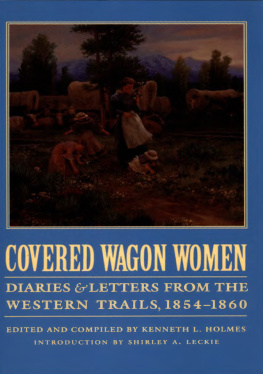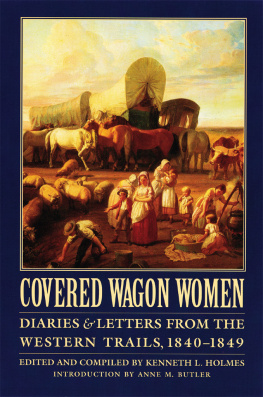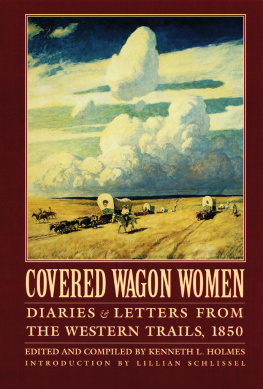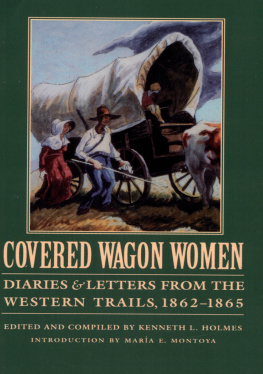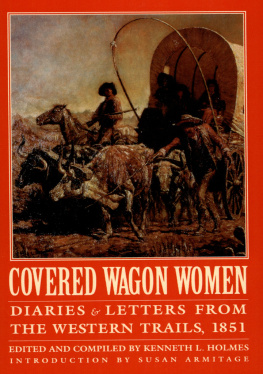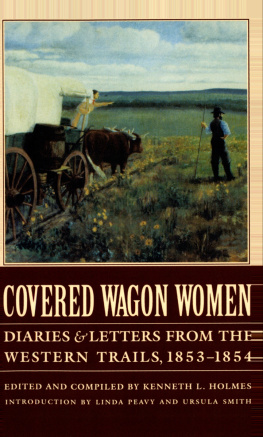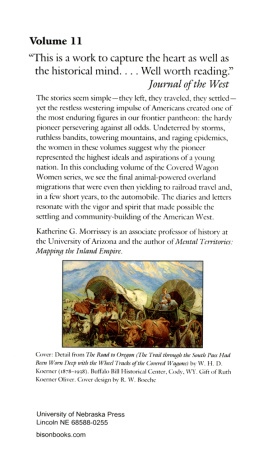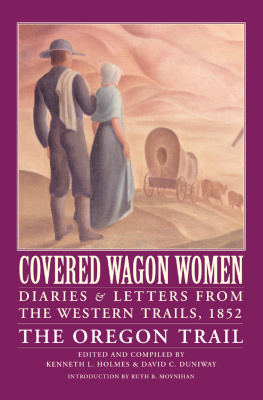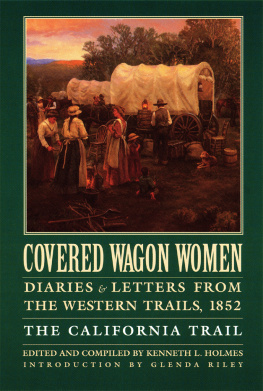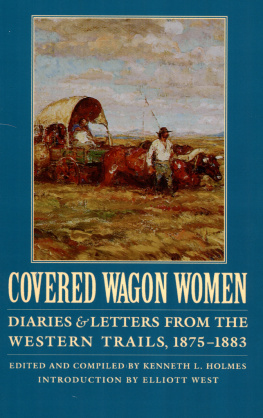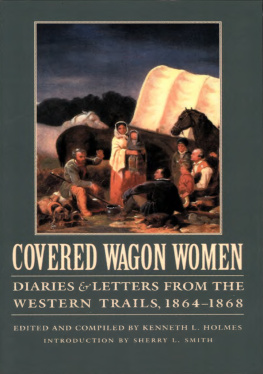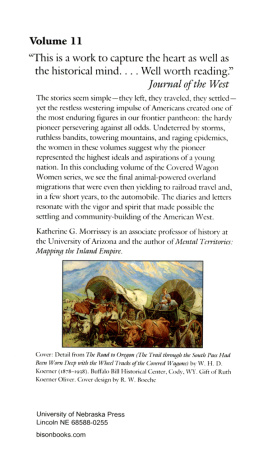Kenneth L. Holmes - Covered Wagon Women, Volume 7
Here you can read online Kenneth L. Holmes - Covered Wagon Women, Volume 7 full text of the book (entire story) in english for free. Download pdf and epub, get meaning, cover and reviews about this ebook. year: 2014, publisher: Bison Books, genre: Home and family. Description of the work, (preface) as well as reviews are available. Best literature library LitArk.com created for fans of good reading and offers a wide selection of genres:
Romance novel
Science fiction
Adventure
Detective
Science
History
Home and family
Prose
Art
Politics
Computer
Non-fiction
Religion
Business
Children
Humor
Choose a favorite category and find really read worthwhile books. Enjoy immersion in the world of imagination, feel the emotions of the characters or learn something new for yourself, make an fascinating discovery.
- Book:Covered Wagon Women, Volume 7
- Author:
- Publisher:Bison Books
- Genre:
- Year:2014
- Rating:3 / 5
- Favourites:Add to favourites
- Your mark:
- 60
- 1
- 2
- 3
- 4
- 5
Covered Wagon Women, Volume 7: summary, description and annotation
We offer to read an annotation, description, summary or preface (depends on what the author of the book "Covered Wagon Women, Volume 7" wrote himself). If you haven't found the necessary information about the book — write in the comments, we will try to find it.
Covered Wagon Women, Volume 7 — read online for free the complete book (whole text) full work
Below is the text of the book, divided by pages. System saving the place of the last page read, allows you to conveniently read the book "Covered Wagon Women, Volume 7" online for free, without having to search again every time where you left off. Put a bookmark, and you can go to the page where you finished reading at any time.
Font size:
Interval:
Bookmark:


1987 by Kenneth L. Holmes. Reprinted by arrangement with the Arthur H. Clark Company.
Introduction to the Bison Books Edition 1998 by the University of Nebraska Press
All rights reserved
The paper in this book meets the minimum requirements of American National Standard for Information SciencesPermanence of Paper for Printed Library Materials, ANSI Z39.481984.
Library of Congress Cataloging-in-Publication Data
The Library of Congress has cataloged Vol. 1 as:
Covered wagon women: diaries & letters from the western trails, 18401849 / edited and compiled by Kenneth L. Holmes; introduction to the Bison Books edition by Anne M. Butler.
p. cm.
Originally published: Glendale, Calif: A. H. Clark Co., 1983.
Reprinted from volume one of the original eleven-volume edition
T.p. verso.
Volume 1.
Includes index.
ISBN 0-8032-7277-4 (pa: alk. paper)
ISBN-13: 978-0-8032-7690-1 (electronic: e-pub)
ISBN-13: 978-0-8032-7691-8 (electronic: e-mobi)
1. Women pioneersWest (U.S.)Biography. 2. West (U.S.)History. 3. West (U.S.)Biography. 4. Overland journeys to the Pacific. 5. Frontier and pioneer life West (U.S.) I. Holmes, Kenneth L.
F591.C79 1996
978dc20 95-21200 CIP
Volume 2 introduction by Lilian Schlissel.
ISBN 0-8032-7274-X (pa: alk. paper)
Volume 3 introduction by Susan Armitage.
ISBN 0-8032-7287-1 (pa: alk. paper)
Volume 4 introduction by Glenda Riley.
ISBN 0-8032-7291-X (pa: alk. paper)
Volume 5 introduction by Ruth B. Moynihan.
ISBN 0-8032-7294-4 (pa: alk. paper)
Volume 6 introduction by Linda Peavy and Ursula Smith.
ISBN 0-8032-7295-2 (pa: alk. paper)
Volume 7 introduction by Shirley A. Leckie
ISBN 0-8032-7296-0 (pa: alk. paper)
Reprinted from volume seven (1987) of the original eleven-volume edition titled Covered Wagon Women: Diaries and Letters from the Western Trails, 18401890, published by The Arthur H. Clark Company, Glendale, California. The pagination has not been changed and no material has been omitted in this Bison Books edition.
The publisher does not have any control over and does not assume any responsibility for author or third-party websites or their content.
Introduction to the Bison Books Edition
Shirley A. Leckie
The message was clear; overlanders should pack as lightly as possible.
By 1854, when Sarah Sutton made her journey to Oregon Territory and Anna Maria Goodell and Elizabeth Austin traveled to Washington Territory, the tide of emigration, after a falling off, had resumed more heavily than ever. In addition to wider dissemination of knowledge, travelers benefited from the organized relief efforts now spearheaded by California and Oregon newspapers intent upon assuring the continual flow of new settlers to the Pacific coast. Moreover, trading posts, often run by former trappers with Indian wives and mtis children, were more abundant. Those heading for California found Salt Lake City a comfortable way station, although prices for labor and supplies were generally high. Perhaps most important to the majority of covered wagon women, who were young and in their childbearing years, the nearly two-thousand-mile trek across the continent could be completed in about five months rather than the six or so required a decade earlier. Nonetheless, whether one describes a diary from the 1840s or 1850s, the most frequent and important notation referred to the miles traveled each day.
How an individual woman experienced emigration, however, depended largely on her age, health, and circumstances beyond her control. Pregnancy, childbirth, nursing children, the death of oxen, the disappearance of cattle, the spread of disease, accidents, or unseasonably cold, hot, wet, or dry weather were factors that often rendered covered wagon travel arduous and dangerous. Moreover, new trails, such as the one residents of Washington Territory carved out in 1853 over the Cascades to connect Fort Walla Walla with Puget Sound, might still prove extraordinarily difficult. Diarists Anna Maria Goodell and Elizabeth Austin experienced that fact a year later.
Harriet Augusta Stewart, Sarahs sixteen-year-old daughter by a former marriage, welcomed the move to Oregon for other reasons. Earlier her mother had described her as not well, but poor health was no reason to stay home. Oregon was viewed as a healthier climate when compared with the ague- and fever-ridden Mississippi River Valley. Personally she wanted to see the curiositys and get gold for sewing & to see the buffalo and to hear the wolves howl (24). In other words, in addition to an exciting adventure, she looked forward to living where female labor brought greater remuneration. Within a year, however, like so many other young women who arrived in Oregon, she was married.
If the trail had become, on the whole, safer for emigrants, it had become more dangerous in one important respect. Although the Native peoples were never the threat portrayed in later Hollywood sagas or even in the reminiscences of pioneers, the emigration westward brought them new hardships. Between 1840 and 1880 the buffalo herds, on which the Plains Indians depended, almost disappeared. Although changes in tribal relationships, new patterns of trade, and periods of drought played a role in this catastrophe, emigrants contributed their share. The overland trains of the 1840s and the smaller parties a decade later included oxen, horses, mules, and other livestock that spread diseases to the buffalo herds. Moreover, the emigrants livestock consumed much of the pasturage that sustained the bison. That, along with the diminishing of other game, such as the elk mentioned in Suttons diary, exacted a heavy toll on the food supply and material well-being of Native peoples.
Moreover, tribal people suffered severely from cholera and other diseases the emigrants brought westward. When Sarah Suttons diary is read carefully, it is obvious that the Native peoples her party encountered along the Platte River and in the area of Independence Rock were in dire straits. A kind woman, Sutton commiserated with them, but she had no inkling that she and her family were contributing to their calamity.
In addition to their misunderstanding of the hardships facing Native peoples, covered wagon women such as Sutton and Goodell disdained the Euro-American traders (often of French ancestry) and their Indian wives whom they met along the trail. They referred to these women as squaws, an ethnocentric term that conveyed the idea that Indian women were beasts of burden without honor among their own people and subject to maltreatment from husbands, whether Native or white.
More recent historical investigation reveals, however, that fur traders who turned to merchandizing or ranching after both the large supply of beaver and the European market for beaver pelts disappeared enjoyed marriages with Native women that were similar to those of other Americans in stability, number of children, and presumably degree of affection. Moreover, given the role Indian wives had played in helping these men forge crucial alliances with various tribes, they were important assets as well as companions.
Finally, of course, the long accepted idea that Indian women were beasts of burden has been challenged. Catherine Price, for example, notes that among the Oglala gender roles were complementary with women and men performing quite different but equally valuable roles (okicicupi). By serving as seers, curers, members of the Medicine Society, or preparers of medicine for war or by becoming expert craftswomen and artisans, Oglala women achieved honor and distinction among their people.
Next pageFont size:
Interval:
Bookmark:
Similar books «Covered Wagon Women, Volume 7»
Look at similar books to Covered Wagon Women, Volume 7. We have selected literature similar in name and meaning in the hope of providing readers with more options to find new, interesting, not yet read works.
Discussion, reviews of the book Covered Wagon Women, Volume 7 and just readers' own opinions. Leave your comments, write what you think about the work, its meaning or the main characters. Specify what exactly you liked and what you didn't like, and why you think so.

